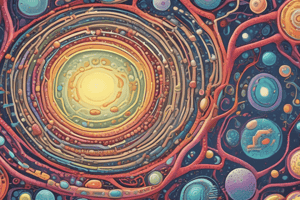Podcast
Questions and Answers
Which of the following characteristics is present in both plant and animal cells, highlighting a fundamental similarity in their structure?
Which of the following characteristics is present in both plant and animal cells, highlighting a fundamental similarity in their structure?
- Plasma membrane regulating the transport of substances in and out of the cell. (correct)
- A large central vacuole primarily for water storage and cell shape maintenance.
- Chloroplasts converting light energy into chemical energy.
- Cell wall providing rigid structure and protection.
A researcher discovers a new cell type that is actively producing steroid hormones. Which organelle would be most abundant in this cell?
A researcher discovers a new cell type that is actively producing steroid hormones. Which organelle would be most abundant in this cell?
- Ribosomes
- Smooth endoplasmic reticulum (correct)
- Lysosomes
- Rough endoplasmic reticulum
A cell needs to transport a large protein out of the cell. Which of the following organelles would be directly involved in packaging and exporting this protein?
A cell needs to transport a large protein out of the cell. Which of the following organelles would be directly involved in packaging and exporting this protein?
- Golgi apparatus (correct)
- Chloroplast
- Mitochondria
- Lysosome
If a eukaryotic cell were unable to produce functional lysosomes, what would be the most likely consequence for the cell's function?
If a eukaryotic cell were unable to produce functional lysosomes, what would be the most likely consequence for the cell's function?
Which of the following best describes the role of the ribosomes in a cell?
Which of the following best describes the role of the ribosomes in a cell?
Following synthesis in the rough endoplasmic reticulum (RER), a protein destined for secretion from the cell must pass through which of the following organelles for further processing and packaging?
Following synthesis in the rough endoplasmic reticulum (RER), a protein destined for secretion from the cell must pass through which of the following organelles for further processing and packaging?
How do vesicles contribute to the overall function and efficiency of a eukaryotic cell?
How do vesicles contribute to the overall function and efficiency of a eukaryotic cell?
Which of the following structural components differentiates a plant cell from an animal cell, providing the plant cell with rigidity and protection?
Which of the following structural components differentiates a plant cell from an animal cell, providing the plant cell with rigidity and protection?
Flashcards
Plasma Membrane
Plasma Membrane
Border for the cell, controls what enters and exits; also known as the cell membrane.
Rough Endoplasmic Reticulum
Rough Endoplasmic Reticulum
Organelle with ribosomes attached; folds, modifies, and transports proteins.
Nucleus
Nucleus
Contains the cell's DNA, controls cell activity.
Ribosomes
Ribosomes
Signup and view all the flashcards
Cell Wall
Cell Wall
Signup and view all the flashcards
Smooth Endoplasmic Reticulum
Smooth Endoplasmic Reticulum
Signup and view all the flashcards
Vesicles
Vesicles
Signup and view all the flashcards
Lysosomes
Lysosomes
Signup and view all the flashcards
Study Notes
- Prokaryotes, animals and plants have different cell characteristics and functions.
Plasma membrane
- Defines the cell boundary.
- Regulates the passage of substances in and out.
- Provides some cell structure.
- Also known as the "cell membrane".
- Present in prokaryotes, animal cells, and plant cells.
Rough Endoplasmic Reticulum (RER)
- Dotted with ribosomes, which translate proteins directly into the ER.
- Proteins are folded, modified, or directed elsewhere within the cell.
- Absent in prokaryotes, present in animal and plant cells.
Nucleus
- Contains the cell's DNA.
- Appears as a dark sphere in the center of the cell.
- Absent in prokaryotes, present in animal and plant cells.
Ribosomes
- Read mRNA and translate it into proteins.
- Can be found in the cytosol or on the ER.
- Appear as tiny dots within the cell and on the ER.
- Present in prokaryotes, animal cells, and plant cells.
Cell Wall
- Provides structure and rigidity to the cell.
- Protects the cell.
- Present in prokaryotes and plant cells, absent in animal cells.
Smooth Endoplasmic Reticulum (SER)
- Primarily synthesizes lipids, including cholesterol and phospholipids.
- Absent in prokaryotes, present in animal and plant cells.
Vesicles
- Small membrane-bound sacs.
- Transport substances around the cell, both in and out.
- Present in animal and plant cells, sometimes in prokaryotes.
Cytoplasm
- The internal content of the cell.
- Liquid part is the cytosol.
- Includes all organelles.
- Present in prokaryotes, animal cells, and plant cells.
Lysosomes
- Membrane-bound sacs containing acids and digestive enzymes.
- Break down cellular waste; function as the cell's "trash receptacle".
- Absent in prokaryotes, present in animal and plant cells.
Chloroplast
- Converts light energy, water, and CO2 into sugar and oxygen through photosynthesis.
- Contains the stroma and the thylakoid membrane.
- Absent in prokaryotes and animal cells, present in plant cells.
Mitochondria
- The site of ATP (energy) production.
- Absent in prokaryotes, present in animal and plant cells.
Cytoskeleton
- Consists of intermediate filaments, microtubules, and actin.
- Involved in cell structure, division, movement, and transport of vesicles and organelles.
- Present in all cell types, but simpler in prokaryotes.
Vacuoles
- Membrane-bound sacs primarily used for storage.
- In plant cells, a large central vacuole helps maintain cell shape and store water.
- Present in animal and plant cells, sometimes in prokaryotes.
Golgi Apparatus
- Packaging center for proteins and lipids from the ER.
- "Ships" them to their appropriate locations inside or outside the cell using vesicles.
- Absent in prokaryotes, present in animal and plant cells.
Studying That Suits You
Use AI to generate personalized quizzes and flashcards to suit your learning preferences.




